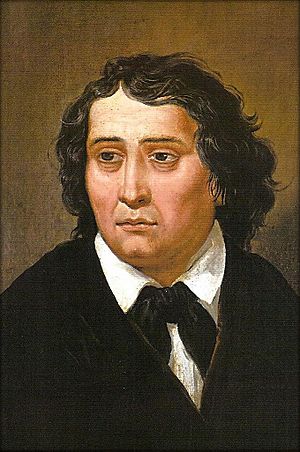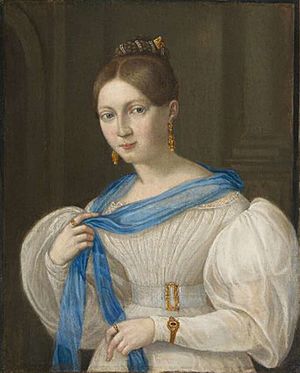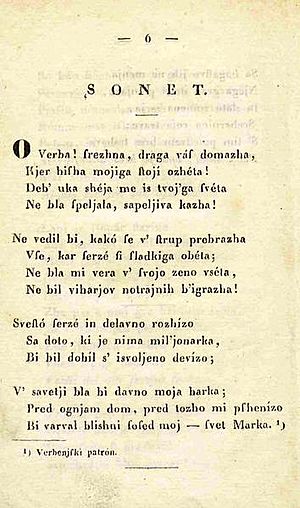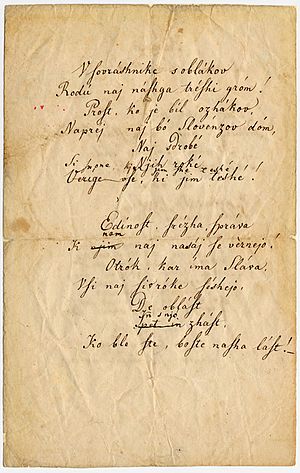France Prešeren facts for kids
Quick facts for kids
France Prešeren
|
|
|---|---|

Prešeren, 1850 oil portrait
|
|
| Born | 3 December 1800 Vrba, Carniola, Habsburg monarchy (now Slovenia) |
| Died | 8 February 1849 (aged 48) Kranj, Austrian Empire (now Slovenia) |
| Occupation | Poet, lawyer |
| Language | Primarily Slovene, some works in German. |
| Nationality | Carniolan, Slovene |
| Literary movement | Romanticism |
| Notable works | The Baptism on the Savica O Vrba Sonnets of Misfortune A Wreath of Sonnets Zdravljica |
France Prešeren (born December 2 or 3, 1800 – died February 8, 1849) was a famous Romantic Slovene poet from the 19th century. His poems have been translated into many languages.
He is seen as the greatest classical poet of Slovenia. He inspired many later Slovene writers. Prešeren wrote the first Slovene ballad and the first Slovene epic poem. After he died, he became the most important name in Slovene literature.
Prešeren often wrote about his own sad love life and the struggles of his homeland. After World War II in the Slovene Lands, many Slovenes saw his idea of "unlucky fate" as a national symbol. People say Prešeren is everywhere in Slovene culture, like the air.
He wrote poems mostly in Slovene, but also in German. He lived in Carniola and first thought of himself as Carniolan. But over time, he felt more connected to a wider Slovene identity.
Contents
Life of France Prešeren
Early Life and Schooling
France Prešeren was born in the village of Vrba. This area was part of the Habsburg monarchy at the time. Today, Vrba is in Slovenia. He was the third of eight children. He was the first son in his family. His family was well-off farmers. His mother was ambitious and educated. She taught her children to read and write. Soon, she sent them to live with their uncles, who were Roman Catholic priests.
When he was eight, he went to elementary schools. These schools were in Grosuplje and Ribnica. Local Roman Catholic priests ran them. In 1812, he moved to Ljubljana, the capital of Carniola. There, he went to the State Gymnasium. He learned Latin, Ancient Greek, and German. German was the main language for education and government then. It was also the language for high culture in most areas where Slovenes lived.
In Ljubljana, the poet Valentin Vodnik encouraged Prešeren. Vodnik helped him improve his writing skills in Slovene. As a high school student, Prešeren became friends with Matija Čop. Čop later became a famous language expert.
In 1821, Prešeren started studying law at the University of Vienna. In Vienna, he read many classic books. These included works by Homer, Goethe, Dante, and Italian writers like Petrarch and Boccaccio. He also read poems by Romantic poets of his time.
Later Years and Career

Prešeren finished his law degree in 1828. He then went back to Ljubljana. He worked as an assistant for a lawyer named Leopold Baumgartner. In 1832, he moved to Klagenfurt for a short time. He hoped to advance his career there. But he returned to Ljubljana in less than a year. In the spring of 1833, he met Julija Primic. She was the daughter of a rich merchant. She became the love of his life, though his feelings were not returned.
In 1833, he joined the Casino Society in Ljubljana. This was a social club for high society. He met Julija there in 1834 and 1835. He saw her at the theater and at dances. But he was too shy to tell her how he felt. In 1834, he started working for his friend Blaž Crobath. Crobath gave Prešeren enough free time to write his poems. That same year, he met the Czech poet Karel Hynek Mácha. He also met the Slovene-born Croatian poet Stanko Vraz. They had many good talks about poetry.
Around 1836, Prešeren understood that Julija would never love him back. She had married another man the year before. In the same year, he met Ana Jelovšek. They started a lasting relationship and had three children together. Prešeren supported Ana financially. He treated her as his partner. He also traveled a lot around Carniola. He especially liked Lake Bled. The beautiful scenery there inspired his poems. In 1846, Prešeren was finally allowed to open his own law firm. He moved to Kranj with his family. He died there on February 8, 1849.
Prešeren's Works
Early Poetic Attempts
Prešeren started writing serious poems during his student years in Vienna. In 1824, he wrote some of his most popular poems. These were influenced by Valentin Vodnik and Slovene folk poetry. In 1825, he finished a collection called "Carniolan poems." He showed them to Jernej Kopitar, a language expert. Kopitar was very critical of the young poet's work. So, Prešeren destroyed the whole collection. Kopitar's criticism slowed down Prešeren's writing. He did not publish anything until 1827. That year, his funny poem "To Maidens" (Dekletom) was published. It appeared in a German newspaper called Illyrisches Blatt.
In 1828, Prešeren wrote his first important poem, "A Farewell to Youth." But it was not published until 1830. It appeared in Krajnska čbelica (The Carniolan Bee). This was a literary magazine started by Miha Kastelic in Ljubljana. The magazine also published another well-known poem by Prešeren that year. It was the first Slovene ballad. It was called "The Water Man" (Povodni mož'). This poem told the story of Urška, a flirt from Ljubljana. She ended up with a handsome man who was a water man.
In 1830, his high school friend, Matija Čop, came back to Ljubljana. He reconnected with Prešeren. Čop quickly saw his friend's talent for poetry. He convinced Prešeren to use Romanic poetic forms. Prešeren followed Čop's advice. He soon became very skilled at writing sonnets. His poems were noticed by the Czech scholar František Čelakovský. Čelakovský wrote several very positive reviews of Prešeren's work. This praise was very important for Prešeren's confidence. It gave him the strength to keep writing as Čop had guided him.
Most Productive Years
Between 1830 and 1835, Prešeren wrote his most beautiful poems. These were inspired by the difficulties in his personal life. Especially, they were about his unreturned love for Julija Primic. Prešeren followed Čop's advice. He turned Julija into a poetic character. She was like Dante's Beatrice or Petrarch's Laura.
A Wreath of Sonnets
A Wreath of Sonnets (Sonetni venec) is one of Prešeren's most important early poems. It is a group of 15 sonnets. It was published on February 22, 1834, in the Illyrian Paper. In this poem, Prešeren connected his sad love story with the struggles of his homeland. Matija Čop recognized the poem as a masterpiece. But it was not widely known outside the small group around the Krajnska čbelica magazine. Also, Julija herself was not impressed. So, Prešeren started writing more bitter poems.
Sonnets of Misfortune
Another important work from this time is the "Sonnets of Misfortune" (Sonetje nesreče). These were first written in 1832. But they were published in the 4th volume of Krajnska čbelica in July 1834, with some changes. They are the most sad of Prešeren's works. This group has six (originally seven) sonnets. They show the poet's deep sadness about life. In the first sonnet, called "O Vrba," Prešeren thinks about how his life might have been different. He wonders what if he had never left his home village. The other sonnets in this group are not as famous. But experts still consider them to be some of Prešeren's most real and deep works.
After Čop's Death
The year 1835 was a very hard year for Prešeren. His closest friend, Matija Čop, drowned in the Sava River. Julija Primic married a rich merchant. Prešeren also grew apart from his friend Miha Kastelic. Kastelic was the editor of the Krajnska čbelica magazine. After his best friend died, Prešeren wrote the long poem The Baptism on the Savica (Krst pri Savici). He dedicated it to Čop. The poem is set during the time when the ancestors of Slovenes, the Carantanians, were forced to become Christians in the late 8th century. The poem talks about being true to one's heritage. It also discusses hope and sadness for individuals.
In 1837, Prešeren met Emil Korytko. He was a Polish activist from Galicia. The Austrian government had sent him to Ljubljana. Korytko showed Prešeren the works of Adam Mickiewicz. Mickiewicz's poems greatly influenced Prešeren's later writing. They even translated one of Mickiewicz's poems together. It was called "Resygnacja" and they translated it from Polish to Slovene. They also started collecting Slovene folk songs. These songs were from Carniola and Lower Styria. Korytko died in 1839. This left Prešeren without an important person to talk to about his work, after Čop's death.
In the autumn of that year, Andrej Smole came home. He was a friend of Prešeren's from his youth. Smole had lived and traveled abroad for many years. He was a wealthy young intellectual. He came from a well-known merchant family. Smole supported the growth of Slovene culture. The two friends spent much of the winter of 1839–1840 at Smole's home in Lower Carniola. They planned several cultural and writing projects. These included starting a daily newspaper in Slovene. They also planned to publish Anton Tomaž Linhart's play Matiček's Wedding. This play had been banned in 1790. It was seen as "politically inappropriate" because of the French Revolution. Both projects failed. The planned newspaper, Ilirske novice, was stopped by the government censors in Vienna. Linhart's play was not performed until 1848. Smole died suddenly in 1840. He passed away in Prešeren's arms while celebrating his 40th birthday. Prešeren wrote a touching poem for his late friend. It was also surprisingly cheerful and full of life.
The Later Years
After 1840, Prešeren had no one who truly understood his work. But he kept writing poetry. He wrote much less than in the 1830s. He slowly moved away from the usual romantic style. He started using a more varied and new way of writing. In 1843, something important happened for Prešeren. Janez Bleiweis started a new daily newspaper in Slovene. He asked Prešeren to write for its culture section. The two men were quite different. Bleiweis was a moderate conservative. He strongly supported the church and the empire. He was not interested in Romantic culture. But they still formed a good working relationship. Prešeren's involvement in Bleiweis's newspaper was the closest he came to being publicly recognized during his life.
In 1844, he wrote the patriotic poem "Zdravljica" (A Toast). This was the most important work of his later period. In 1847, a book of his collected poems was published. It was simply called Poezije dr. Franceta Prešerna (Poems of Dr. France Prešeren).
Prešeren spent his last two years focused on his personal life. He also worked at his new job as a lawyer in Kranj. Some say he was planning new writing projects. These included a novel in a realistic style. He also thought about an experimental play. The revolution of 1848 did not seem to affect him much. Even though young people saw him as a hero for democratic and national ideas. Before he died, he did edit his Zdravljica. This poem had been left out of the 1847 collection. He also made small changes for a new edition of his collected poems.
Legacy
Prešeren's impact on Slovene culture is huge. He is generally seen as the national poet. In 1905, his monument was placed in the main square in Ljubljana. This square is now called Prešeren Square. By the early 1920s, all his remaining works were listed. Many special editions of his works were published. Several experts studied only his work. Little was left unknown about his life. In 1945, the day he died, Prešeren Day, was made the Slovene cultural holiday. In 1989, his poem Zdravljica became the national anthem of Slovenia. It replaced the old anthem, Naprej, zastava slave. In 1992, his picture was on the Slovene 1000 tolar banknote. Since 2007, his image is on the Slovene two-euro coin. The highest Slovene award for art, the Prešeren Award, is named after him.
See also
 In Spanish: France Prešeren para niños
In Spanish: France Prešeren para niños





